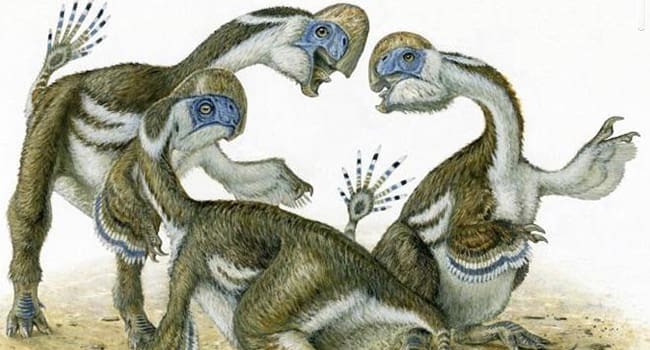
“The same [three-fingered] phenomenon has been seen in some other kinds of dinosaurs, most famously the tyrannosaurs, but in this case it was unexpected.” says lead author Greg Funston (Image credit: Michael Skrepnick)
“This study focuses on a spectacular fossil – a block of three bird-like dinosaurs preserved together,” said Greg Funston, lead author of the study. Funston completed part of the research during his doctoral studies in the Department of Biological Sciences under the supervision of Philip Currie.
“Initially, we suspected that these fossils might be already known, but after comparing them to the possibilities, it became clear that there were significant differences that told us we were looking at a new species.”
The specimens belong to a group called oviraptorids, a subgroup of a larger group called oviraptorosaurs. The study names this new species, Oksoko avarsan, describes the morphology of its skeleton, and explores some of the biological information the fossils provide about these dinosaurs.
 “The two-fingered hand was a completely unexpected twist. As I was initially working on the specimen, I noticed that most of the knuckle bones of the third finger were missing in the fossil,” said Funston.
“The two-fingered hand was a completely unexpected twist. As I was initially working on the specimen, I noticed that most of the knuckle bones of the third finger were missing in the fossil,” said Funston.
“To my surprise, even though the bones were completely surrounded by rock and the finger should have been preserved, the third finger still only had one bone,” said Funston.
“Looking more closely at this bone, we could tell that it didn’t form a joint, and so we could be confident that this species only had two fingers in life. This is unusual because other species in the group all have three fingers, and no one had ever suspected that these animals were losing their digits over time.
“The same phenomenon has been seen in some other kinds of dinosaurs, most famously the tyrannosaurs, but in this case it was unexpected.”
This didn’t strike researchers as unusual – fossils are almost always found damaged or incomplete – but upon unearthing the other hand, they realized they had found something special.
The find prompted scientists to look at the evolution of the hands and forelimbs closely, shedding new light on evolutionary trends as subgroups within the larger oviraptorosaur group migrated to different areas.
This pattern shows that these animals were highly adaptable, and researchers suspect that this is related to their dietary flexibility, said Funston.
“The pattern of diversification and adaptation that we see fits into an ongoing puzzle of whether dinosaurs were already in decline before their extinction 66 million years ago. A lot of new work has shown that this is probably not true. Our work shows that this group was flourishing in Asia just before the extinction, and so the pattern we thought we saw in North America is probably not representative of the whole world.”
| By Andrew Lyle
This article was submitted by the University of Alberta’s online publication Folio, a Troy Media content provider partner.
The views, opinions and positions expressed by columnists and contributors are the author’s alone. They do not inherently or expressly reflect the views, opinions and/or positions of our publication.


